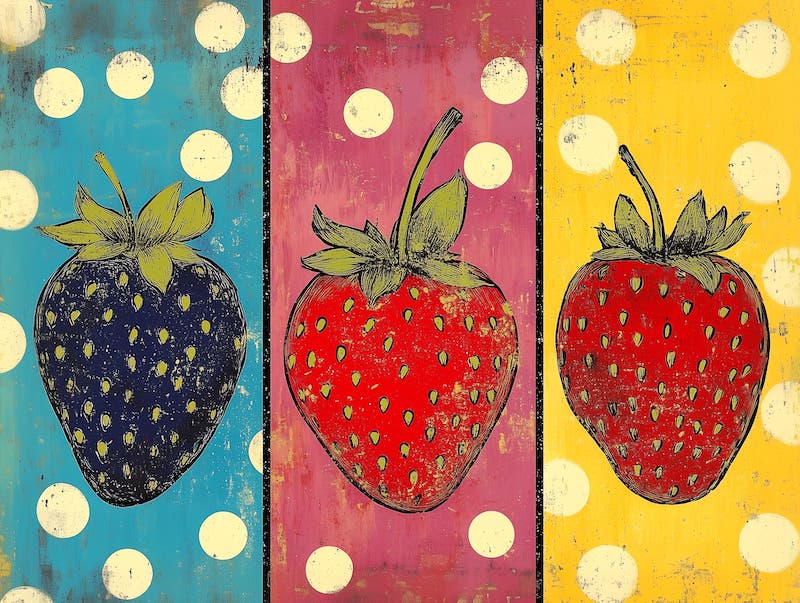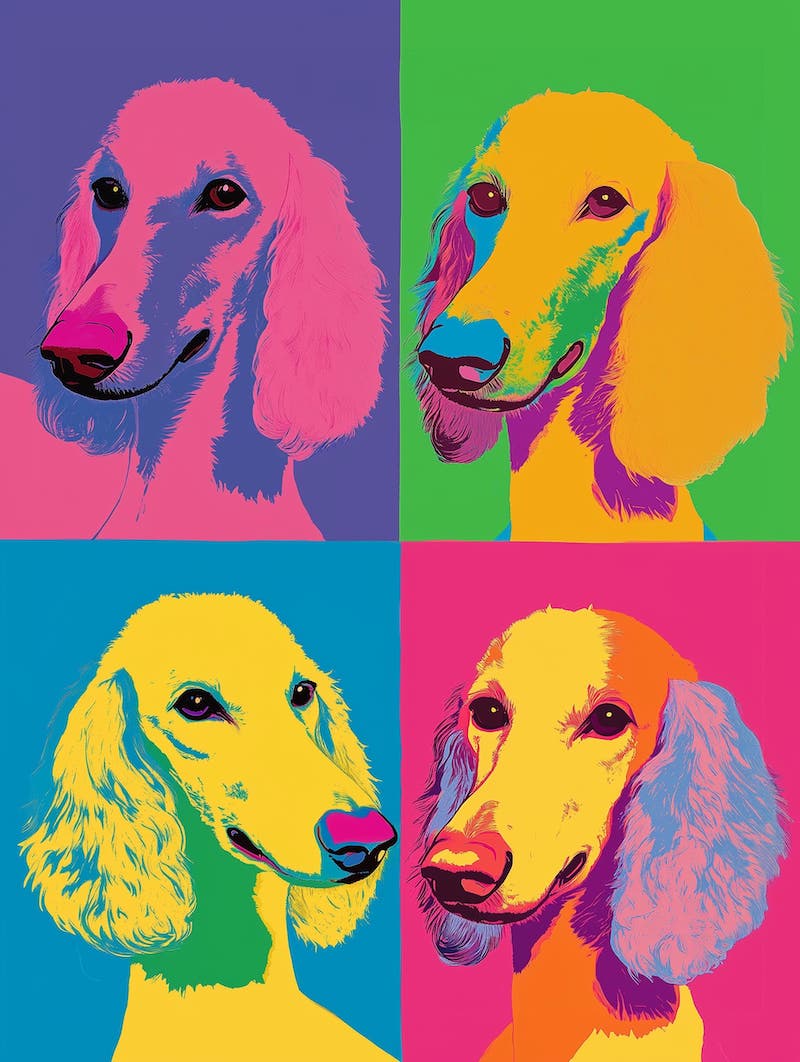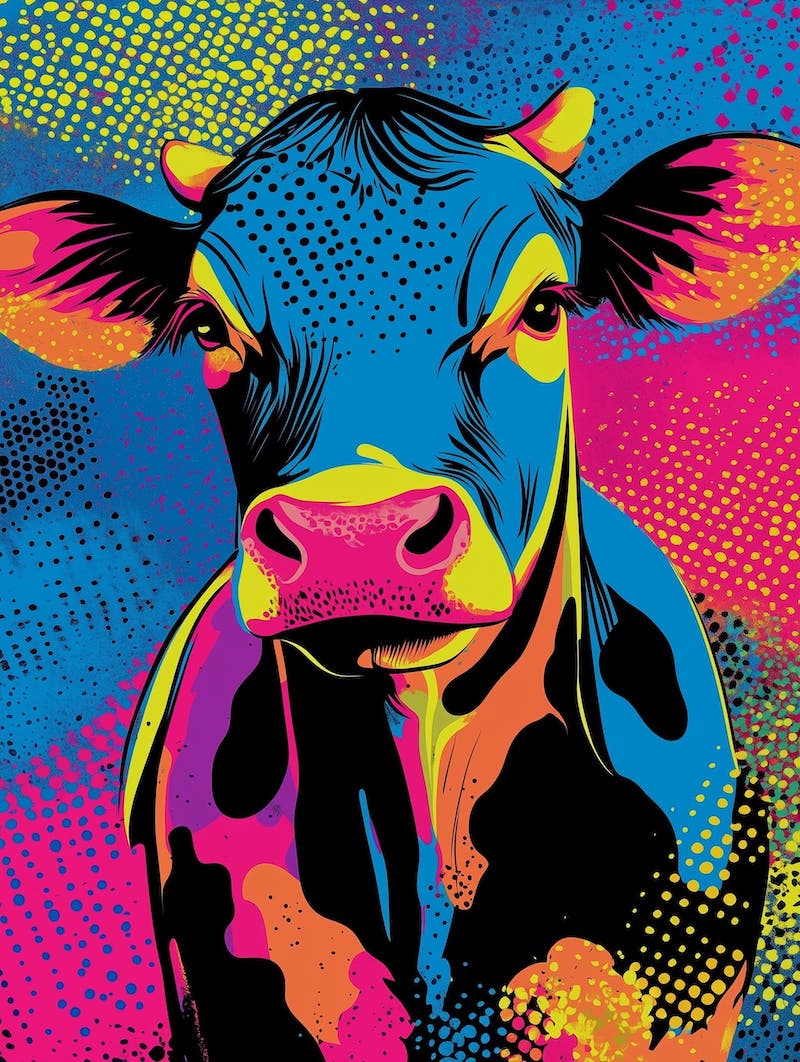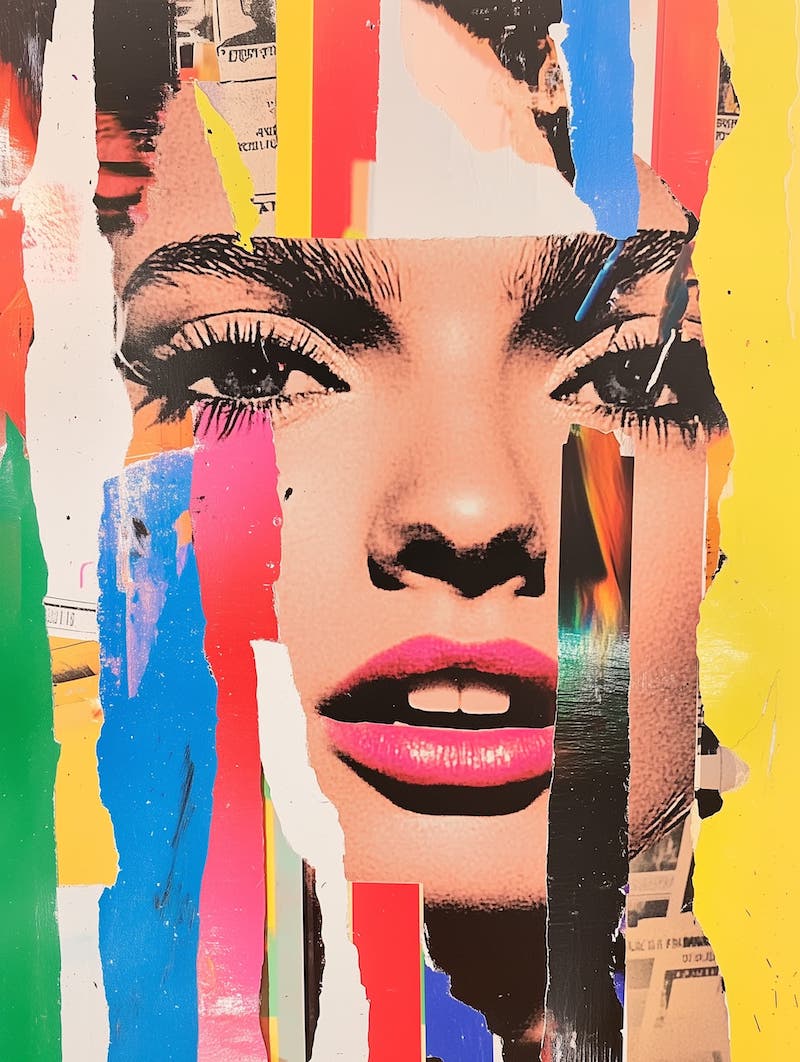Pop Art is a visual art movement that emerged in the 1950s and 1960s. It challenged modern art by highlighting ordinary, everyday consumer culture and mass media imagery through bold colors, recognizable imagery, and commercial techniques.
Is it eye candy or a profound artistic gesture?
Many asked themselves this question when Pop Art first arrived in the hyper-intellectual climate of mid-20th-century art. Today, we’re used to seeing Pop Art’s influence in wall decor, advertising, and clothing. We forget that this movement shook the art world to its core.
Before Pop Art, artists seemed to take pride in being hard to understand. They portrayed themselves as gatekeepers of an intensely expressive avant-garde that was somehow above everyday people. Pop Art was a playful recontextualization of modernism’s precedent. It demonstrated the first shift from modern to contemporary and made so-called “fine art” more relatable.
If Pop Art inspires your home decor, learning about its history, key characteristics, and famous artists will ensure that you get the look right.
Origins of Pop Art: A Brief Overview
Pop Art was a response to a changing world. The movement’s approachable methods of producing and displaying art were spurred by technologies that transformed everyday life seemingly overnight. During the Pop Art movement, television had become the dominant medium in American homes, and new printing techniques made it faster than ever to reproduce images.
The now famous pop art artists adopted these new mediums, elevating “low” techniques to the status of fine art.
Pop Art held a glittering appeal: it was always new, trendy, and culturally “with it.” From comic books and rock-&-roll to chic Hollywood starlets and Campbell’s soup cans, nothing was too mundane to become art.
Pop Art brought art more in line with pop culture—breaking down walls artists and critics alike had come to take for granted. Artists like Roy Lichtenstein, Andy Warhol, and Claes Oldenburg worked with ideas developed in the U.K. by artists associated with the Independent Group—among them Richard Hamilton and Eduardo Paolozzi. Artists like Yayoi Kusama pursued a parallel trajectory inspired by the countercultural currents Pop Art was often associated with.
Pop Art quickly became a global phenomenon.
Setting the Stage: Post-War Culture and the Rise of Consumerism
Before the Pop Art movement officially kicked off, the embers of an authentic counterculture were already starting to become visible in the 1950s. WWII had recently ended, and new technologies were rapidly becoming available to ordinary citizens. Artists, as well as scientists and theorists, were attuned to these changes and were equally excited and concerned about their applications in the postwar world.
In the U.K., new generations of artists were incorporating brands, logos, and catchphrases into their work. Inspired by Surrealism, one of the first Pop Art works to use recognizable branding—Eduardo Paolozzi’s I Was a Rich Man’s Plaything (1947)—might be viewed as both fascinated by and skeptical of consumerism’s escalating influence.
Pop Art Is Born in the U.K.
Following Paolozzi, British Pop Art was mostly nurtured by a think tank called the Independent Group, which held weekly meetings at the Institute of Contemporary Arts. These meetings focused mainly on the proliferation of new media, viewing art as capable of developing a new form of social commentary around this phenomenon.
In many respects, figures like Richard Hamilton and Eduardo Paolozzi, both of whom helped pioneer ideas that would become central to British Pop Art, inspired early Pop Art practitioners in the U.S.
When the movement took hold in America, pop artists amplified the foundational ideas and solidified the bold commercialism that now defines it. These artists wholeheartedly adopted mass media, producing artwork with spectacular speed and near-reckless abandon.
Pop Artists Revolt Against Preceding Art Movements
Pop Art positioned itself against the high seriousness of Abstract Expressionism. Abstract Expressionism (or Ab-Ex) underscored emotional intensity, while Pop Art embraced irony, playfulness, and urbane superficiality.
In an effort to make art more communicative and accessible, pop cultural symbols, which already carried a collectively shared meaning, became vastly preferable to the arcane personal symbolism of Abstract Expressionism.
In the end, Pop Art’s highly familiar, even friendly imagery made it more approachable to the general public, in contrast with Abstract Expressionism’s formidable obscurity.
Key Characteristics of Pop Art Style
The Pop Art movement revolutionized the visual arts through commercial techniques like screen printing, bold acrylics, collage, and photomontage—methods that deliberately mirrored mass production. Key characteristics of pop art include bright, saturated colors, hard edges, and flattened perspective that eliminated depth in favor of graphic impact.
Artists embraced mechanical reproduction, repetition, and enlargement to transform everyday imagery into striking compositions. Beyond technical innovation, Pop Art was defined by its ironic appropriation of advertising imagery, comic book panels, celebrity portraiture, and consumer products—blending high and low culture while adopting a seemingly detached, occasionally humorous stance toward its subject matter.
Use of Popular Culture and Mass Media
One of pop art’s most defining characteristics is its rejection of the seriousness and self-importance of Abstract Expressionism and other preceding modern art movements.
The art critic Clement Greenberg, an important theorist of Abstract Expressionism, once wrote that avant-garde art was unique and original, as opposed to kitsch, which was mass-produced and inauthentic. He claimed that avant-garde art was “the only living culture” and that anything related to pop culture and mainstream media was a threat to true cultural standards.
Pop artists flipped Greenburg’s ideas upside down. They broke all the rules by working with industrialized mediums, recognizable imagery, and pop culture icons.
In both its British and American incarnations, Pop Art blended “high” and “low” culture, avant-garde and kitsch, in ways that made the mass-produced seem singular and unique while also making fine art look like something you would find at a shopping mall or boutique.
Bright Colors, Bold Lines, and Repetition

Surrounded by mass productions in the form of consumer goods, Pop Art noted how repetitions specific to one medium would leak into another—just like live TV actors singing jingles similar to what one would hear on the radio. Pop Art often mimicked the factual (some might even say sterile) production features that had become an integral part of the modern world.
The movement’s signature bright colors, bold outlines, and strategic repetition became visual hallmarks that both celebrated and critiqued consumer culture, creating instantly recognizable works that captured attention, much like the advertisements they referenced.
For example, Andy Warhol’s silkscreen prints of Campbell’s soup cans mimicked the cans’ arrangement in grocery aisles. And Lichtenstein’s paintings of comic book panels, which often thematized crushingly dramatic moments, were playful restatements of Ben-Day dots (think old-school comic book images).
Silkscreen Printing

Silkscreen printing was originally used as a cheap way to distribute promotional material. From window displays to hanging ceiling signs, silkscreen posters were a prominent feature of modern life. Its inexpensiveness, combined with its serial ease, made it a go-to medium during the Great Depression.
By the time Andy Warhol started working with the technique, it already had important connotations for the American public at large. So he made the boring, repetitious silkscreen process a reflection of its own banality. In short, he used screen-printing to critique screen-printing. Placing commercial images on the pedestal of fine art, Warhol dissolved the boundary between artistic expression and graphic design.
Ben-Day Dots & Comic Strip Aesthetics

Ben-Day dots are small, colored dots used in printing to create shading and secondary colors. They’re named after Benjamin Henry Day Jr., who invented the technique in 1879. They were created so that newspapers and comic books could mass-produce colorful, textured images with fewer inks and lower costs.
Roy Lichtenstein mimicked the printing process of comic books by hand-painting Ben-Day dots. He also used bold black contours around his figures and incorporated speech bubbles into his work—all in an effort to introduce the world of comics into fine art.
In doing this, Lichtenstein was not so concerned with comic books as objects of beauty but as artifacts that already existed in the world around us. Creating a graphic, cartoon-like style that blurred the line between fine art and popular culture, he didn’t want viewers to return to their childhood so much as to showcase something visual culture, even in its more avant-garde forms, had contemptuously passed over.
Collage and Photomontage

Artists like Richard Hamilton and Eduardo Paolozzi used collage and photomontage to reflect consumerism and media saturation, which they saw as a characteristic part of modern life under capitalism. Significantly, works like Paolozzi’s I Was a Rich Man’s Plaything (1947) and Richard Hamilton’s Just what is it that makes today’s homes so different, so appealing? (1956) are less surreal than archival. The technique of collage is used to demonstrate the incoherence of modern consumerist society.
Iconic Pop Artists and Their Works
Andy Warhol
One of the most visible figures in American Pop Art, Warhol’s use of silkscreen printing—which is practically industrial in its methodology—was an early foray into making paintings that didn’t rely on the artist’s hand. Using silkscreen as a tool, Warhol introduced themes like Campbell’s Soup Cans and Marilyn Monroe into the lexicon of art, and his fascination with mass production made his works about fame and consumerism take on a conceptual meaning.
- Campbell’s Soup Cans (1962) – A series of 32 paintings depicting different Campbell’s soup flavors, reflecting mass production and consumer culture.
- Marilyn Diptych (1962) – A silkscreen painting of Marilyn Monroe repeated 50 times, exploring celebrity, mortality, and media saturation.
- Eight Elvises (1963) – Features eight overlapping images of Elvis Presley in cowboy attire, merging pop culture, fame, and repetition.
- Gold Marilyn Monroe (1962) – Shows Monroe’s face centered on a large gold background, evoking both religious iconography and celebrity worship.
- Silver Car Crash (Double Disaster) (1963) – Part of the “Death and Disaster” series, using repetition of a car accident image to confront media desensitization.
- Brillo Boxes (1964) – Sculptures resembling Brillo soap pad packaging, questioning the boundaries between art and commercial design.
- Mao (1972) – A colorful silkscreen portrait of Chairman Mao that fuses political imagery with pop art aesthetics.
- Self-Portrait (1986) – A haunting final work showing Warhol’s ghostly head, reflecting themes of mortality and personal identity.
Roy Lichtenstein
Roy Lichtenstein’s comic book style of painting is also a hallmark of Pop Art style. In works like Whaam! (1963) and Drowning Girl (1963), for example, he wraps the childlike nostalgia of reading a comic with mature themes to create contrast and dissonance. War and romance are presented here in an achingly over-the-top way, which makes the viewer reflect on their own values.
- Whaam! (1963) – A diptych inspired by comic books, showing a fighter jet firing a missile, capturing violence and drama in pop culture style.
- Drowning Girl (1963) – Depicts a woman crying in a comic panel, highlighting themes of melodrama, emotion, and mass-produced romance.
- Look Mickey (1961) – A playful painting featuring Mickey Mouse and Donald Duck, marking Lichtenstein’s shift to comic book imagery.
- Brushstroke (1965) – Enlarges a single brushstroke to a monumental scale, satirizing abstract expressionism’s emphasis on spontaneity.
- Oh, Jeff…I Love You, Too…But… (1964) – Features a tearful woman and a dramatic comic-style dialogue bubble, critiquing romance tropes.
- In the Car (1963) – A close-up of a tense couple in a car, rendered in bold lines and Ben-Day dots, evoking mid-century comics and emotional restraint.
Claes Oldenburg
Although not born in the U.S., Claes Oldenburg found a home in American culture. His oversized works, such as Clothespin (1976) and Floor Burger (1962), deal with the normalization of consumerism in our daily lives—exaggerating the size of banal objects but keeping them from appearing overwhelming or fantastical. Translating ordinary objects into soft sculptures, which contrasts with their monumentality, reflects the Surrealist influence that inspired European versions of Pop Art since day one.
- Floor Cake (1962) – A giant soft sculpture of a slice of cake made from foam and canvas, blurring the line between food and art.
- Giant Soft Fan (1966) – A drooping sculpture of an electric fan, transforming a rigid household object into something floppy and playful.
- Lipstick (Ascending) on Caterpillar Tracks (1969) – A public sculpture combining a tank base and a giant lipstick, mixing war and consumerism.
- Clothespin (1976) – A 45-foot-tall steel clothespin was installed in Philadelphia, turning a mundane object into an urban monument.
- Spoonbridge and Cherry (1985–1988) – A whimsical sculpture of a spoon with a cherry on top, placed in a Minneapolis sculpture garden.
- Soft Toilet (1966) – A sagging sculpture of a toilet made of vinyl and foam, poking fun at domesticity and functional design.
Other Notables: Richard Hamilton, James Rosenquist, Yayoi Kusama
Richard Hamilton – An early pioneer of Pop Art before it even had a label. Hamilton was a member of the Independent Group. One of his most recognizable works—Just what is it that makes today’s homes so different, so appealing? (1956)—provides an early use of collage to express Pop Art themes.
James Rosenquist – An important figure in American Pop Art, Rosenquist used collage to highlight the disconnect between the ideals of American life (individualism, convenience, consumerism) and the political realities that undermined them. Paintings such as President Elect (1960–61/1964) were reworked to suggest the eerie strangeness of events and investigations that followed in the wake of Kennedy’s assassination.
Yayoi Kusama – Japanese-born artist Yayoi Kusama emerged as a countercultural force within Pop Art during her time in 1960s New York. Her work tends to thematize repetition (often dots) in a way that is more formalist and abstract than works generally associated with the movement. Still, her work is nothing if not anti-elitist and accessible, which aligns her with Pop Art’s legacy.
The Legacy of Pop Art
Influence on Contemporary Art and Design
Pop Art paved the way for postmodernism in many respects, particularly its anti-elitist attitude and refusal to distinguish between “high” and “low” culture.
Another key aspect of Pop Art, which postmodernism continued, was the rejection of modernist ideals. Rejecting modernism’s seriousness, Pop Art, like postmodernism, was able to create a new aesthetic framework for the reception of art, where being “interesting” was synonymous with being “good.”
In the realms of graphic design, street art, and pop culture more generally, Pop Art has maintained significant influence well into the current day. Assimilating influences from popular culture, it was only fitting that Pop Art should also recreate and change them on its own terms. Today, graphic design—from corporate branding to gas station signage—not only reflects the influence of Pop Art but remains a living testament to the cultural realities that served as Pop Art’s key inspiration.
Pop Art in Fashion, Advertising, and Music
Pop Art has also had a lasting influence on fashion, interior design, and music. Artists such as Lady Gaga and Jay-Z are interested not only in the aesthetics of Pop Art but also in the countercultural attitude associated with the movement. Contemporary fashion brands like Moschino proudly wear the mantle of Pop Art.
Pop Art: So Much More Than a Fleeting Movement
Andy Warhol once said, “In the future, everyone will be world-famous for 15 minutes.” This seems to have panned out with the advent of social media, where personal branding and appearances count for more than anything modernist depth could ever have anticipated.
Pop Art wasn’t merely reflecting the commercial culture of its time—it was anticipating our current visual landscape with remarkable accuracy. The movement’s embrace of mass production techniques, celebrity obsession, and consumer imagery created a new artistic language that continues to resonate in our digital age. From Instagram filters that echo Warhol’s color palettes to meme culture that follows Lichtenstein’s comic panel aesthetic, Pop Art’s DNA is embedded in how we communicate visually today.
What began as a radical departure from abstract expressionism has become the visual vocabulary of our everyday lives, proving that these iconic artists weren’t just documenting their present—they were glimpsing our future.




